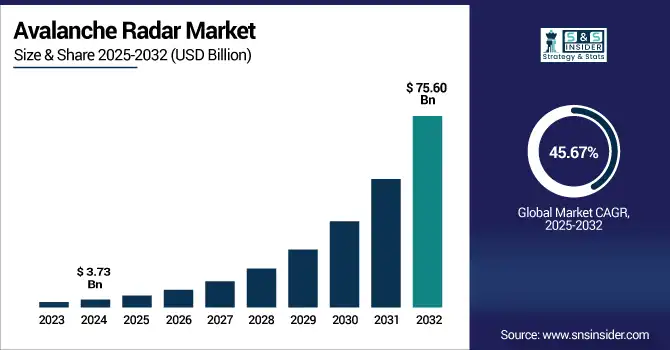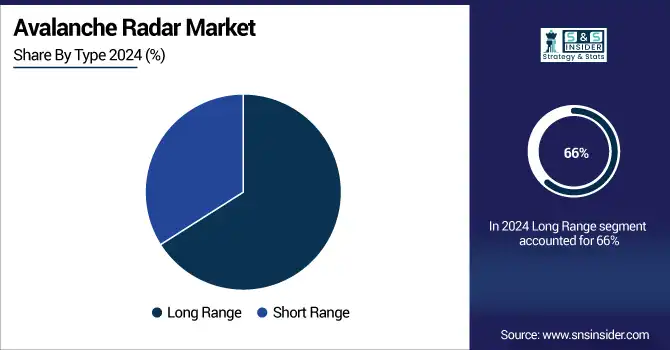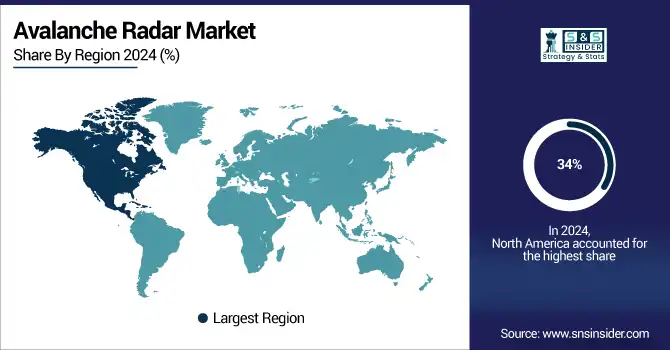Avalanche Radar Market Size & Trends:
The Avalanche Radar Market size was valued at USD 3.73 Billion in 2024 and is projected to reach USD 75.60 Billion by 2032, growing at a CAGR of 45.67% during 2025-2032.

To Get more information on Avalanche radar market- Request Free Sample Report
The avalanche radar market is expanding steadily, driven by increasing climate volatility, increased sensitivity towards natural disaster preparedness, and the rapid requirement for early warning systems in the snow affected areas. The information systems provide life-saving real-time data, enabling faster response and recovery; vital for saving lives, infrastructure investment and economic activity. The accuracy and efficiency of the system are greatly enhanced with automation of radar detection, AI-driven analysis, and its integration with long-haul communication networks perhaps the most influential of these new features. Moreover, the market is driven by public safety efforts, infrastructure up-gradation, and inclination towards proactive disaster management. With the need for hardy, low-maintenance and reliable solutions increasing in end user applications, avalanche radar technology is now an important element of a holistic monitoring system.
20 January 2025 – Geobrugg, in collaboration with HKUST and IMHE, successfully tested its debris flow barriers at the world’s largest facility in Dongchuan, China. All systems withstood extreme loads, validating real-world performance and guiding future product development.
The U.S Avalanche Radar Market was valued 0.86 in 2024 and is projected to reach USD 14.69 Billion by 2032, growing at a CAGR of 42.58% during 2025-2032. This Avalanche Radar growth is driven by rising climate risks, increased investment in early warning systems, and rapid adoption of advanced radar technologies.
Avalanche Radar Market Dynamics:
Drivers:
-
Automation and Advanced Sensing Technologies Fuel Growth in Avalanche Radar Market
The avalanche radar market is being driven by rapid advancements in sensing technologies, focus on early warning systems, and requirement of automation in snow hazard assessment are promulgating the significance of the avalanche radar market. Increasing climate variability and greater frequency of disasters related to snow are prompting governments, research institutions and infrastructure operators to spend on smart, real-time monitoring tools. Expansion of the market is further aided by the adoption of near-infrared sensing, enhanced imaging, and AI to enhance snowpack instabilities detection. Such systems improve safety, reduce manual labour and expedite decision-making in high-risk areas. This has led to an avalanche radar market trends in the industry towards smaller, scalable, field-deployable technologies that can be easily incorporated into national and regional disaster preparedness arrangements.
21 January 2025 – Swiss authorities awarded a patent to SLF researchers for the “Snowimager”: an apparatus that utilizes near-infrared light to automatically study snow layers for predictable avalanches. The new technology would replace the traditional analogue profile, and allow for rapidly detecting weak snow layers, ideally to upgrade early-warning systems.
Restraints:
-
High Costs and Harsh Terrain Conditions Hinder Avalanche Radar Market Expansion
Despite strong growth prospects, the avalanche radar market faces several key restraints. High installation and maintenance costs limit adoption, particularly in developing regions with constrained budgets. Harsh environmental conditions in mountainous areas can impact equipment durability and increase operational challenges. Limited accessibility in remote terrains also complicates deployment and servicing. Additionally, the need for skilled personnel to operate and interpret radar systems poses a barrier in regions lacking technical expertise. Data integration issues with existing weather and emergency response systems may further delay real-time decision-making. Furthermore, regulatory approvals and slow public infrastructure development can hinder large-scale implementation. These factors collectively create operational, financial, and logistical hurdles that could slow market penetration despite rising awareness of avalanche-related risks.
Opportunities:
-
Emerging Opportunity in Dual-Use Radar Technologies for Avalanche Monitoring
The evolving landscape of radar innovation is unlocking new opportunities in the avalanche detection market. As governments and industries look for improved early-warning radar systems, the requirement for radar platforms that can deliver high-resolution terrain analysis and real-time snowpack monitoring is increasing. It represents an opportune moment for dual-use technologies—radars that were designed to serve a military and aerospace function are finding new life in the management of environmental hazards. Being accurate, portable and durable, makes them perfect for avalanche-prone areas. The intersection of defense-level technology with green monitoring is part of an overall shift toward a more intelligent approach to safety solutions. Broader deployment of common, crossover radar capabilities will enable companies to be the leaders in both public safety and advanced sensing markets.
Kongserg launched new AMRAAM-ER missile on NASAMS system and the GhostEye MR radar to improve ballistic threats interception.
Challenges:
-
Persistent Technical, Cost, and Integration Barriers Challenge Avalanche Radar Market Expansion
The avalanche radar market faces several key challenges despite growing demand. One major issue is the high cost of advanced radar systems, which limits adoption, especially in developing or remote regions. Technical check bounds including inaccuracy in extreme weather conditions, and challenging terrain are the other limitation factors for reliability. Integration with other infrastructure such as weather stations and emergency networks can be complicated and expensive. The absence of standard formulations and data interchange specifications between systems is another obstacle for large scale deployment. There are also constraints on skilled manpower for system operations and maintenance in remote areas. Finally, challenges related to data privacy and regulation can obstruct implementation, especially in military-sensitive or cross-border areas where the use of radar system coincides with security considerations.
Avalanche Radar Market Segmentation Analysis:
By Type
The Long Range segment held a dominant Avalanche Radar Market share of around 66% in 2024, due to the increasing requirement of wide-area coverage and early-warning accuracy and is widely deployed in the high-risk and mountainous areas which need long distance detecting hazards for the avalanche prevention and response on time.
The Short Range segment is expected to experience the fastest growth in the Avalanche Radar Market over 2025-2032 with a CAGR of 51.70%. This surge is driven by increasing adoption in localized monitoring, ski resorts, and urban-edge mountain zones where compact, cost-effective radar solutions are preferred for real-time avalanche detection and safety management.

By Component
The Transmitter segment held a dominant Avalanche Radar Market share of around 24% in 2024, demonstrating its vital profile in propagating the signal precisely for avalanche detection systems. If the demand has been building over the last few years for sure it is now finally a huge market demand for reliable and high performance components in order to guarantee data transmission with radar whether it will be short or long range radar with snow.
The Antennas segment is expected to experience the fastest growth in the Avalanche Radar Market over 2025-2032 with a CAGR of 47.77%. This development is fueled by growing interest in advanced antenna technology which enlarge the range and resolution of radar in compact and mobile systems for millisecond real-time monitoring for avalanches in dynamic and remote mountain terrains.
By End User
The Military and Defense segment held a dominant Avalanche Radar Market share of around 46% in 2024, The above mentioned dominance is a result of the need for advanced hazard detections systems required to maintain the safety of the troop in the mountainous areas combined with frequent investments in terrain surveillance technologies for operational planning and disaster risk reduction.
The Weather Monitoring segment is expected to experience the fastest growth in the Avalanche Radar Market over 2025-2032 with a CAGR of 48.46%. This increase is due to the growing investments in climate resilience, the requirement for precise real-time snowpack data, and increasing adoption of radar systems in meteorological setup to improve the avalanche forecasting and public safety.
Avalanche Radar Market Regional Insights:
In 2024, North America dominated the Avalanche Radar market and accounted for 34% of revenue share, this growth is attributed to the huge investment made in the advanced hazard detection technologies, strong military and weather monitoring structure and high MI adoption across the mountainous areas. Government financial support and regimentation of deployment in avalanche-hazardous areas also contributed to the region's dominant market position.
The Avalanche Radar market in the U.S. is expanding steadily, fueled by rising investments in early warning systems, military-grade radar integration, and increasing adoption across ski resorts and mountainous infrastructure.
Asia-Pacific is expected to witness the fastest growth in the Avalanche Radar Market from 2025 to 2032, with a projected CAGR of 48.15%. because it has the largest population in the world and due to the rising demand for advanced safety radar system in Asia Pacific countries such as China, India, Japan, and South Korea. This growth is attributed to increasing investments in disaster management infrastructure, rising focus of the government on climate resilience and a surge in the deployment of radar systems in avalanche-prone areas including Himalayas, Japan, and Central Asia for early warnings and safety.
Europe emerged as a promising region in the Avalanche Radar Market, driven by stringent public safety regulations, a strong network of research institutions, and increasing investments in mountain hazard monitoring initiatives. The region’s growth potential is further supported by a competitive landscape featuring major vendors and the deployment of advanced radar systems across alpine nations such as Switzerland, Austria, and France.
LATAM and MEA is experiencing steady growth in the Avalanche Radar market, due to the growing awareness of natural calamities and the rise in the usage of advanced monitoring technology. Market evolution in high altitude and mountainous regions prone to landslides and avalanches is backed by government efforts, upgraded infrastructure and international tie-ups.

Get Customized Report as per Your Business Requirement - Enquiry Now
Key Players:
The Avalanche Radar Market Companies are Kongsberg Gruppen, Geobrugg AG, Wyssen Avalanche Control AG, GEOPRAEVENT AG, Vaisala Oyj, Recco AB, L.B. Foster Company, Arva Equipment, Mistral Solutions Pvt. Ltd., Hexagon AB. and Others.
Recent Developments:
-
In September 2024, Hexagon unveiled its next-gen Collision Avoidance System featuring 4D radar and CAS Insights, enhancing vehicle-to-object detection and safety in GNSS-denied zones.
-
In April 2025, Geobrugg set a new world record in rockfall protection with its RXE-12500 barrier, which withstood a 25-ton concrete block impact at 115 km/h, absorbing over 12,500 kilojoules of energy.
| Report Attributes | Details |
|---|---|
| Market Size in 2024 | USD 3.73 Billion |
| Market Size by 2032 | USD 75.60 Billion |
| CAGR | CAGR of 45.67% From 2024 to 2032 |
| Base Year | 2024 |
| Forecast Period | 2025-2032 |
| Historical Data | 2021-2023 |
| Report Scope & Coverage | Market Size, Segments Analysis, Competitive Landscape, Regional Analysis, DROC & SWOT Analysis, Forecast Outlook |
| Key Segments | • By Type(Long Range, Short Range) • By Component (Transmitter, Antennas, Processor, Receiver, Display) • By End User (Military and Defense, Government, Weather Monitoring) |
| Regional Analysis/Coverage | North America (US, Canada, Mexico), Europe (Germany, France, UK, Italy, Spain, Poland, Turkey, Rest of Europe), Asia Pacific (China, India, Japan, South Korea, Singapore, Australia, Taiwan, Rest of Asia Pacific), Middle East & Africa (UAE, Saudi Arabia, Qatar, South Africa, Rest of Middle East & Africa), Latin America (Brazil, Argentina, Rest of Latin America) |
| Company Profiles | The Avalanche Radar market companies are Kongsberg Gruppen, Geobrugg AG, Wyssen Avalanche Control AG, GEOPRAEVENT AG, Vaisala Oyj, Recco AB, L.B. Foster Company, Arva Equipment, Mistral Solutions Pvt. Ltd., Hexagon AB. and Others. |

